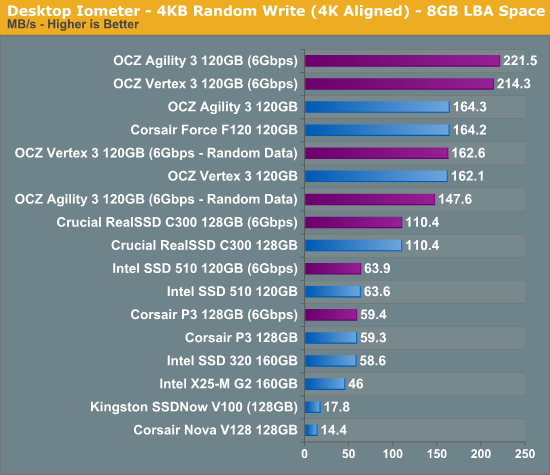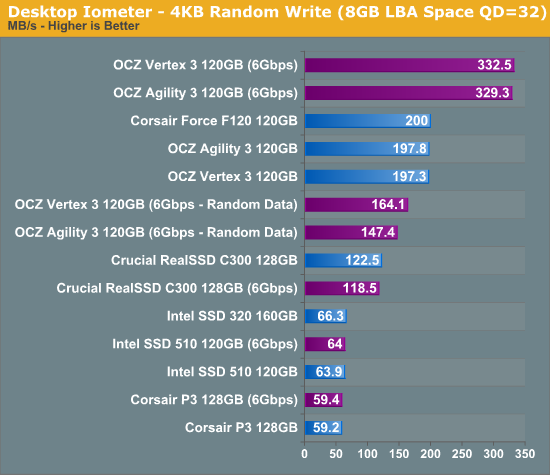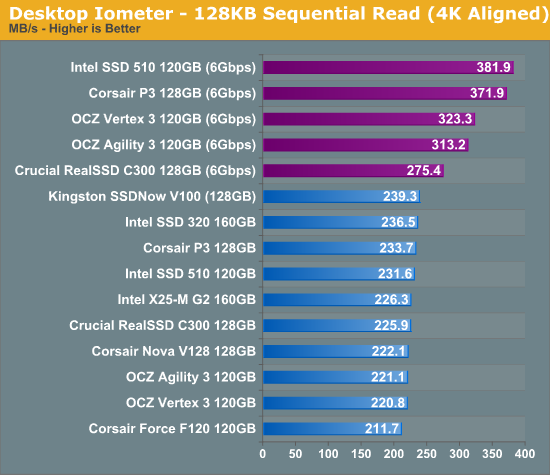The 2011 Mid-Range SSD Roundup: 120GB Agility 3, Intel 510 and More Compared
by Anand Lal Shimpi on June 7, 2011 12:52 PM ESTRandom Read/Write Speed
The four corners of SSD performance are as follows: random read, random write, sequential read and sequential write speed. Random accesses are generally small in size, while sequential accesses tend to be larger and thus we have the four Iometer tests we use in all of our reviews.
Our first test writes 4KB in a completely random pattern over an 8GB space of the drive to simulate the sort of random access that you'd see on an OS drive (even this is more stressful than a normal desktop user would see). I perform three concurrent IOs and run the test for 3 minutes. The results reported are in average MB/s over the entire time. We use both standard pseudo randomly generated data for each write as well as fully random data to show you both the maximum and minimum performance offered by SandForce based drives in these tests. The average performance of SF drives will likely be somewhere in between the two values for each drive you see in the graphs. For an understanding of why this matters, read our original SandForce article.

At worst, SandForce's small file random write performance is equal to its closest competitors, but at best it is significantly greater. Both the Vertex 3 and Agility 3 take the cake here. The Marvell based solutions are significantly slower, however we'll see if that matters in the real world tests.
Many of you have asked for random write performance at higher queue depths. What I have below is our 4KB random write test performed at a queue depth of 32 instead of 3. While the vast majority of desktop usage models experience queue depths of 0 - 5, higher depths are possible in heavy I/O (and multi-user) workloads:

At higher queue depths the advantage just grows for the SF-2281 drives.

Crucial optimized very heavily for random read performance, and to this day nothing (even the replacement m4/C400) can outperform the C300 in our small file random read test. Intel's SSD 510 is the next fastest 6Gbps drive we've got here, followed by the P3 and eventually the Vertex 3/Agility 3.
Sequential Read/Write Speed
To measure sequential performance I ran a 1 minute long 128KB sequential test over the entire span of the drive at a queue depth of 1. The results reported are in average MB/s over the entire test length.

To post high sequential read speeds you need to have a 6Gbps interface these days. Armed with one the Intel SSD 510 and Corsair P3 both post the highest scores here. Even the Vertex 3/Agility 3 are a bit behind the two Marvell drives.

Sequential write performance is another story entirely. With highly compressible data the Vertex 3 is untouched and even in the worst case it's still among the fastest drives. I'll chalk this one up as a win for OCZ, however the rest of the competitors do well here.










68 Comments
View All Comments
voidi - Wednesday, June 8, 2011 - link
I've been waiting for an article like this for a long time. I think there are more people interested in the middle-class, 120GB SSDs, because everything above that capacity is still very expensive, and 120GBs should prove sufficient for most users to store the OS + a load of programs + all games you currently play from time to time. Twice the space is always nice, of course, but I don't feel it's necessary.Thank you so much for this review!
voidi - Wednesday, June 8, 2011 - link
By the way, in Europe, the Agility 3 120GB is currently ~180 € with shipping, whereas the Vertex 3 120GB goes for ~215 €. Interesting to see that the pricing is so different in the US, even in favor of the Vertex sometimes.voidi - Wednesday, June 8, 2011 - link
I just realized you corrected that already, nevermind :)wvh - Wednesday, June 8, 2011 - link
Thanks for the article. It seems there really isn't a bad choice amongst those options, depending on one's priorities.Anand, could you do a short section on encryption in the next article? There are lots of manufacturers who claim their products support encryption, but there's a lot of conflicting information out there and it would be good to know which drives – if any – offer reliable encryption from a data security point of view, and how they provide this security (ATA boot? TPM?).
jensend - Wednesday, June 8, 2011 - link
I was among those clamoring for this a while back, and would like to thank you for doing this review. Hopefully comparative reviews of lower-than-highest-capacity SSDs will become commonplace throughout the tech world moving forward.anotherengineer - Wednesday, June 8, 2011 - link
Great review Anand. However on the first page with the SSD comparison table, how come you didn't include the firmware version that was used for the testing?Thanks
sean.crees - Thursday, June 9, 2011 - link
First, i didn't see the F120 in the price graph in the beginning, but noticed it in the benchmarks.On a 3gb controller, its performance is very competative, and the power consumption is among the best available.
Then i went to newegg to check the price. $215 for the 120g is a lot less than anything else in this round-up. Thats only $179 per GB. So it is simultaniously the best total price, and best price per GB. With the top 3 best performance on a 3gb controller, and the best power consumption.
How is the F120 not highly recommended in this review?
The one thing that i think Anand forgets is that 3gb controllers are still more common, especially if your using an SSD to upgrade an existing laptop/desktop computer.
JasonInofuentes - Thursday, June 9, 2011 - link
Not sure if this is specifically why Anand didn't include it, but part of the trouble with reviewing tech hardware is that it's always unclear just how long a piece of technology will stay not just relevant but available. Is the Corsair a competitive drive in the SATA II space? You bet, I actually was thinking of putting one to use in my system. Is it pretty available on sites like NewEgg? Yeah, but for how long. It's an older drive at this point and the amount of time it stays on the market is unknown. Better to tell you, and the guy that checks this article out in August after he's earned some cash over the summer for a new build, what is the best drive that WILL be available in a few months, and likely for a while after that.What I think everyone is really itching for is the $/GB to fall steeply thanks to the move to 25 nm NAND. The era of $1/GB SSDs are probably still some ways off, but I would hope that we could enjoy a drift towards $1.5/GB before 19 nm NAND hits the streets.
Jason
superccs - Thursday, June 9, 2011 - link
Every time I come here I see you look at performance on multiple platforms, which makes sense , but lately it seems that it is Intel board X and Intel board Y. How hard is it to find a 890 board and throw some new toy in it?There are quite a few peeps out there who use AMD hardware so throw us a bone damnit.
.
Mitch101 - Thursday, June 9, 2011 - link
What we need now is a reliability report. I know of several people (3) with SSD drives and all have experienced a drive failure and these are desktops not servers, no defrag, with virtual swap files. Speed is great but if I have to replace the drive every 6-9 months because of failure Im staying away.